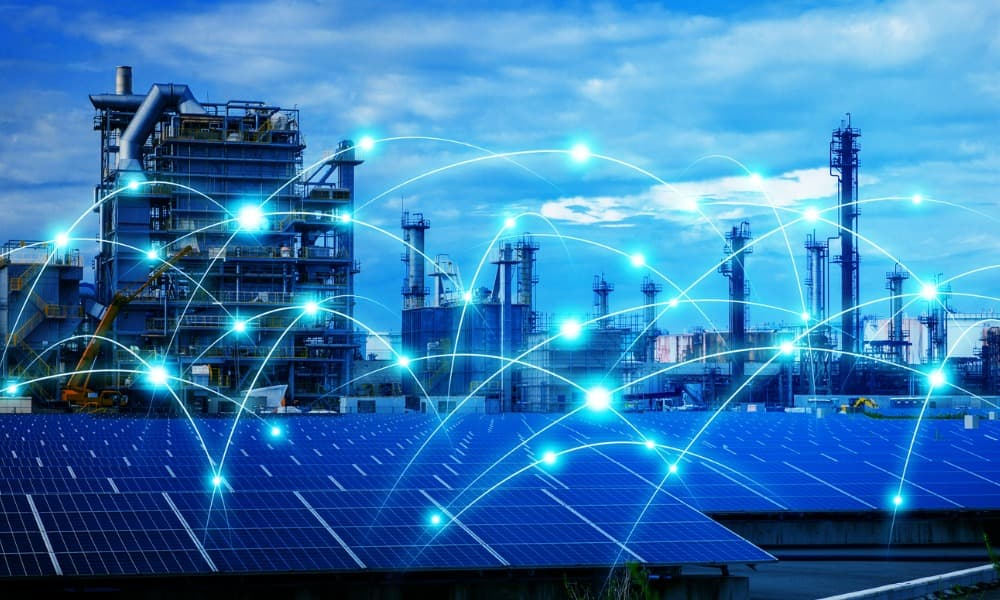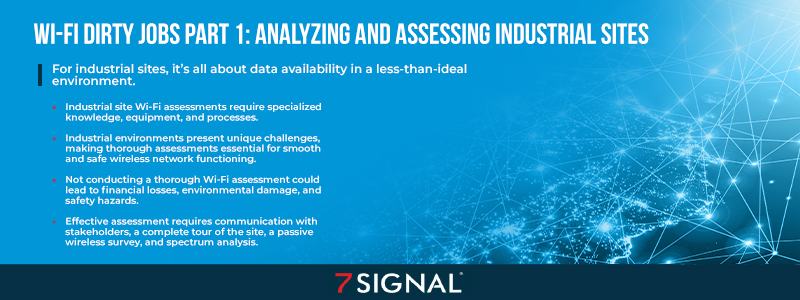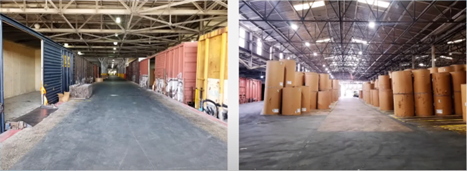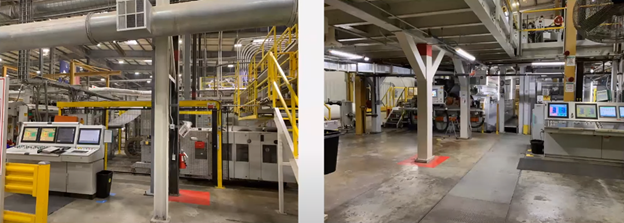
Blog
For industrial sites, it’s all about data availability in a less-than-ideal environment.

Every occupation has its “dirty jobs.” Those are the difficult jobs that deviate from the usual and come with inherent challenges. One such dirty job is conducting a Wi-Fi analysis of an industrial site. In Wi-Fi Dirty Jobs: Analyzing and Assessing Industrial Sites, Scott McNeil discusses the unique challenges of setting up Wi-Fi in industrial settings.
This is centered around OT (operational technology), not IT. Both use much of the same equipment, but the rules are different. Data availability trumps everything, including security and integrity, which, while still important, are secondary considerations. In an industrial Wi-Fi setting where critical systems operate over a wireless network, if the data doesn’t arrive, it can cause a halt in the process. This can lead to several problems, from environmental damage to financial losses.
Why wireless assessments are done
The most direct answer is to get an understanding of the RF airspace. This is important in every instance. However, for the industrial sector, interference comes from different things that must be considered.
It’s important to know what’s happening and the frequencies involved, whether IoT, general wireless access, or specialized point-to-point communications. In addition, assessments are required:
- To troubleshoot and optimize current wireless networks
- For new client access to industrial Wi-Fi
- For machine-to-machine wireless communications
- For sensor deployments
- For LoRaWAN deployments
- For WirelessHART deployments
- For ISA100 deployments
Assessments are also required for greenfield situations, including an old industrial plant that has never had wireless access or a brand-new build. New builds mean there are fewer preexisting conditions to work around or mitigate. Either way, knowing what’s going on in that airspace is essential.
Then there are sensor deployments. The assessment includes checking the environment to ensure everything is stable with the RF. A complete understanding of the site and where sensors will be placed will help determine the success of any wireless initiative project, whether it’s WirelessHART or ISA100.
What makes industrial assessments more challenging?
Assessing industrial environments
Industrial assessments can be daunting, especially when dealing with complex facilities requiring specialized knowledge and equipment. Each site presents its own challenges, and here are some real-life examples.
Indoor train yard at a brown stock paper facility

When you think about an industrial environment, you might envision a warehouse, but that’s not always true.
It’s much more complicated than that. As you can see, this indoor train yard is also a brown stock paper facility. While it may look like a warehouse, when was the last time you saw train cars and a rail system in one?
The issues
In the same environment, you have steel train cars, a reinforced concrete steel corrugated roof, and the stock, which are huge rolls of paper. This presents several issues:
- Reflection: all that steel and reinforced concrete reflect signals everywhere
- Paper: paper eats wireless signals
- Environmental elements: While there’s a roof, there’s still exposure to the elements, and because this site is in Florida, there’s high heat and humidity to consider. There’s also dust from the paper and human activity.
These factors make up a multi-faceted environment that requires thoughtful consideration. It’s about the RF in this situation and the equipment’s longevity.
Rubber roofing manufacturing facility

Let’s move from trains and paper to commercial rubber roofing manufacturing. Many issues like heat and humidity affect RF and physical equipment survivability.
The issues
In this environment, many chemicals are used, everything is metal, and there is piping and conduits everywhere.
It’s the environment where standard Wi-Fi won’t get the job done. Everything will work as expected in the open areas, but when you move under a ledge, your RSSI goes from 64 to the low 80s.
There’s also a lot of reflectivity, causing retransmits to increase significantly.
To further illustrate how different things can be in an industrial setting, here are some examples of what’s encountered:
- Rusty antenna cables because an indoor access point was being used with external antennas that were unprotected and mounted flat to concrete columns that warp transmissions.
- Using off-the-shelf equipment in a hostile environment running DHCP, mounted on a wall that gets hit by every vehicle driving by.
- A tank farm in coastal Mississippi where every LMR connection had bare metal, and they were taking on water.
These are everyday things found in industrial settings due to a lack of professional deployment. They are sold equipment that they need help figuring out where to put, how to protect it, and how to use it, but whoever sold them the equipment isn’t providing that.
The essential parts of an industrial wireless assessment
Doing an assessment doesn’t just mean looking for potential issues. It’s a process that requires many conversations and includes:
- Meeting with the stakeholders. This should include anyone who works in the area. This gives a deeper understanding of their problems, what’s working and not working. Are specific devices having problems, or are all the devices not working? Speaking to everyone at the site gives a better, clearer picture.
- Getting to know the site. Take a full tour of the site, not just the areas that fall within the scope of the job. Assess the areas around it to understand their impact on RF interference.
- Conducting a passive wireless survey. This allows for a clear view of what’s happening within the facility and uncovers any major issues that must be addressed.
- Spectrum analysis. This allows you to see the raw RF values and gives greater visibility into where there’s RF interference. Once you know where the interference is happening, you’ll determine if it can be mitigated or has to be worked around.
It takes about a week to gather data and another week to compile and analyze it to create a report that’s easy for the client to understand.
Importance of Wi-Fi assessments for industrial sites
In conclusion, conducting a Wi-Fi analysis of an industrial site is a “dirty job” that requires specialized knowledge and processes. While assessments are necessary in every instance, industrial environments present unique challenges, such as interference from various sources, complex facilities requiring specialized equipment, and environmental factors.
However, the importance of conducting Wi-Fi assessments in industrial settings cannot be overstated. Not doing one could lead to financial losses, environmental damage, and safety hazards. It is crucial to approach these jobs with professionalism, diligence, and expertise to ensure that wireless networks in industrial settings function smoothly and safely.
Optimize Wi-fi Networks with 7SIGNAL
To ensure your Wi-Fi network is optimized for performance, the 7SIGNAL platform allows you to validate your Wi-Fi design, identify areas for improvement, and proactively detect network issues.
When assessing Wi-Fi issues, it’s important to start with the basics but be prepared to escalate to dedicated Wi-Fi teams to find the root causes of persistent and common problems. 7SIGNAL’s wireless experience monitoring platform includes Sapphire Eye™ and Mobile Eye™, which provide continuous testing and monitoring of connections, enabling you to get to the bottom of what’s happening. Our platform reports over 600 KPIs, giving network managers the visibility they need to identify issues and implement solutions, ranging from simple equipment fixes to enhanced network design and validation.
Contact 7SIGNAL to learn how we can help you assess and optimize your Wi-Fi performance.
7SIGNAL® is the leader in wireless experience monitoring, providing insight into wireless networks and control over Wi-Fi performance so businesses and organizations can thrive. Our cloud-based wireless network monitoring platform continually tests and measures Wi-Fi performance at the network’s edges, enabling fast solutions to digital experience issues and more robust connections for mission-critical users, devices, and applications. Learn more at www.7signal.com.